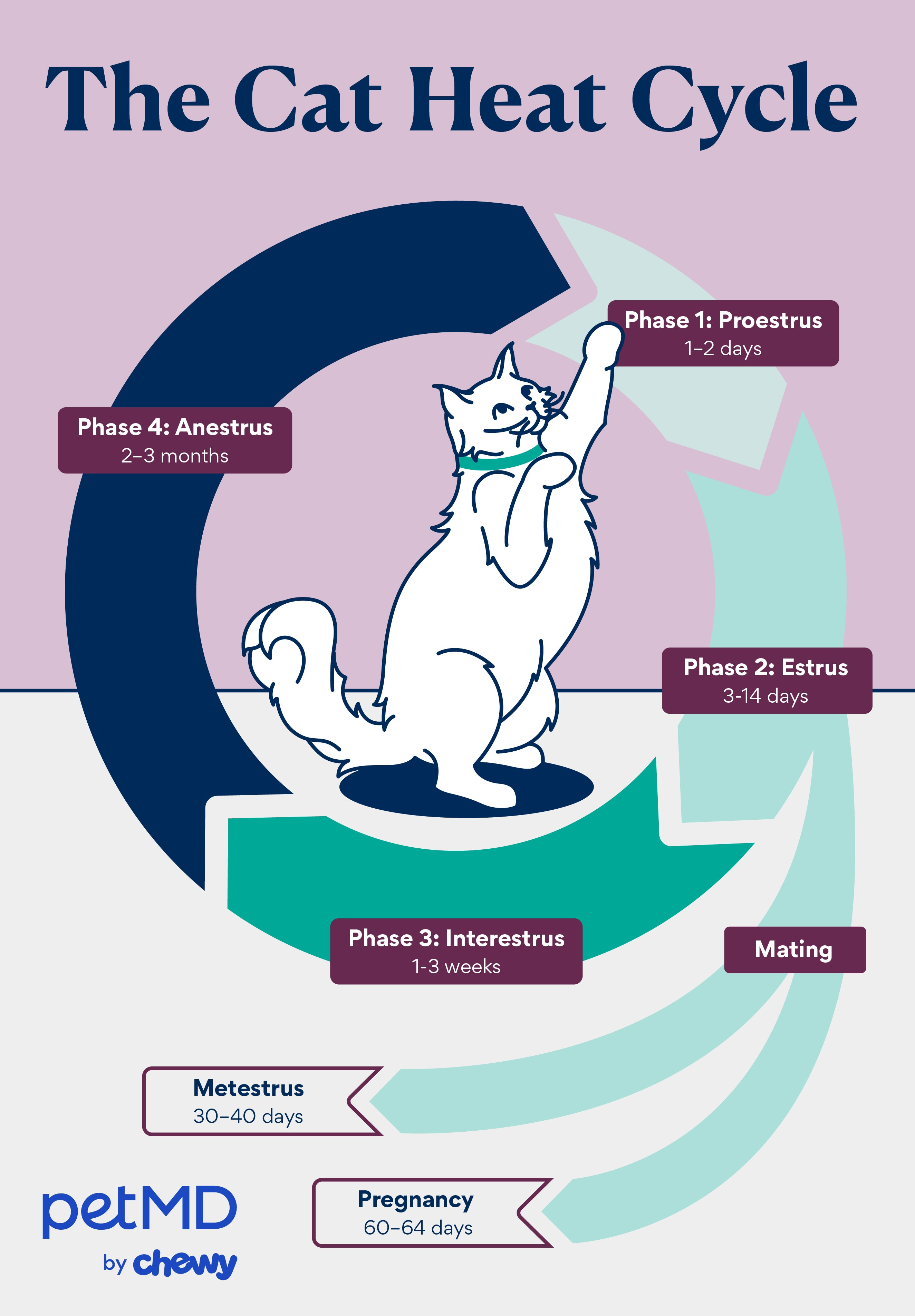For cat owners who haven’t spayed their feline companions, understanding the heat cycle, or estrous cycle, is crucial. Unlike dogs or humans, a cat’s heat cycle has unique characteristics. If you’re wondering about your queen (an intact female cat) and her reproductive cycle, particularly How Long Does A Female Cat Stay In Heat, this comprehensive guide will provide you with all the essential information.
Decoding the Age of First Heat in Cats
The age at which a cat experiences her first heat can vary, but generally, most cats begin their estrous cycles between 5 to 9 months old. However, some kittens may start as early as 3-4 months, while others might not until they are around 18 months old. Several factors influence this timeline:
- Breed: Certain breeds may mature earlier or later than others.
- Weight: A cat’s physical development and weight play a role in hormonal onset.
- Time of Year: Cats are seasonal breeders, and the time of year significantly impacts when they start cycling.
The Cat Heat Cycle Stages and Duration: A Detailed Look
The feline heat cycle is not a continuous state but rather a series of stages. When we talk about “how long a female cat stays in heat,” we’re typically referring to the Estrus stage, which is the most noticeable phase. Let’s break down the four main stages of the cat heat cycle to understand the overall duration:
1. Proestrus: The Prelude to Heat
Proestrus is the initial stage where estrogen levels begin to rise in a female cat’s body. This phase is quite short, usually lasting only 1 to 2 days. Interestingly, there are often no visible symptoms to cat owners during proestrus. You might not even realize your cat is entering her cycle. However, male cats might sense hormonal changes and show increased interest in the female, though she won’t be receptive to mating yet.
2. Estrus: The Peak “In Heat” Phase
Estrus is what most people recognize as a cat being “in heat.” This is the phase where the female cat is receptive to mating. Answering the core question, the Estrus stage typically lasts for about a week, but it can range from 3 to 14 days. This variability depends on individual cats and environmental factors.
During estrus, a female cat exhibits marked behavioral changes that are hard to miss:
- Increased Affection: She may become excessively affectionate, rubbing against furniture, walls, and people more than usual.
- Excessive Vocalization: One of the most prominent signs is increased vocalization. Cats in heat often yowl, meow loudly, and make distinctive calling sounds to attract male cats.
- Restlessness: She may appear agitated, pacing around the house, and seem unable to settle down.
- Mating Posture: She might adopt a characteristic posture – the lordosis position – where she crouches low in the front, raises her rear end, and moves her tail to the side. This posture signals her readiness to mate.
It’s crucial to understand that estrus is the stage where mating occurs. If you do not want your cat to become pregnant, it’s imperative to keep her indoors and away from intact male cats during this period.
3. Interestrus or Metestrus: The Post-Estrus Intervals
Cats are induced ovulators. This biological mechanism means that a female cat’s ovaries will only release eggs if she mates with a male cat. The period following estrus depends on whether mating occurred. This leads to two possible stages:
-
Metestrus (Post-Ovulation if Mating Occurred): If a cat mates during estrus, her ovaries release eggs, and the heat cycle pauses. If fertilization does not occur, the stage is called metestrus, and it lasts for 30–40 days. If fertilization does occur, it leads to pregnancy, which lasts approximately 60–64 days.
-
Interestrus (No Mating): If a cat in estrus does not mate, ovulation doesn’t happen. Instead of metestrus, she enters interestrus. This is a period of 1 to 3 weeks where “in heat” behaviors subside. After interestrus, the cycle will restart with proestrus again if the seasonal and environmental conditions are still favorable for cycling.
4. Anestrus: The Inactive Phase
Cats are seasonal breeders, meaning their reproductive cycles are strongly influenced by daylight hours. Anestrus is a period of reproductive inactivity. It typically occurs during the shorter daylight months of the year, usually for 2 to 3 months, often in the late fall and winter in temperate climates. During anestrus, there is minimal hormonal activity, and the cat is not cycling or in heat.
Understanding these stages clarifies that “how long a female cat stays in heat” is most accurately answered by the duration of the Estrus stage, which is roughly a week, but the entire cycle is more complex and influenced by various factors.
 illustration depicting a cat
illustration depicting a cat
Alt text: Illustration depicting the four stages of a cat’s heat cycle: Proestrus, Estrus, Interestrus/Metestrus, and Anestrus, highlighting the hormonal changes and behavioral signs in each phase for cat owners.
How Often Do Cats Go into Heat? Seasonal Cycling Explained
The frequency of cat heat cycles is heavily influenced by seasonal changes and daylight hours. Cats are “long-day breeders,” meaning their cycles are more frequent and regular when daylight hours are increasing.
- Peak Season: Heat cycles are most common starting in the spring, typically peaking from February to April in the Northern Hemisphere.
- Cycling Period: Heat cycles can continue through the warmer months, often lasting until October or November.
- Interruptions: The cycle will only be interrupted if the cat mates and becomes pregnant, or if anestrus begins due to decreasing daylight hours.
This seasonal pattern explains why you might notice your cat exhibiting heat behaviors more intensely during certain times of the year.
Recognizing the Signs: Is Your Cat in Heat?
Unlike dogs, cats do not bleed during their heat cycle. Therefore, recognizing a cat in heat relies primarily on observing behavioral changes. Here are the most common signs:
- Overwhelming Affection: An increased need for attention and physical contact, becoming unusually cuddly and affectionate.
- Excessive Vocalization: Loud meowing, yowling, and calling, often sounding distressed or persistent.
- Reduced Appetite: Some cats may eat less during heat.
- Restlessness and Agitation: Pacing, inability to settle, and general unease.
- Changes in Urination Habits: While less common, some cats may urinate more frequently or inappropriately outside the litter box as a way to mark territory and attract males.
It’s understandable for pet owners to be concerned that their cat is in pain due to the intensity of these behavioral changes. If you are unsure or worried about sudden behavioral shifts, consulting with your veterinarian is always recommended to rule out any underlying medical issues.
What to Do When Your Cat Is in Heat: Management and Care
If your cat is in heat and you do not want her to get pregnant, the most crucial step is to prevent her from going outside. Unsupervised outdoor access during heat significantly increases the risk of unwanted pregnancy.
Beyond preventing pregnancy, there are generally no necessary lifestyle changes for a cat in heat. However, careful monitoring is important.
- Observe Cycle Length and Frequency: Keeping track of your cat’s heat cycles can help you identify any irregularities.
- Watch for Complications: Be aware of potential issues like pseudopregnancy (false pregnancy) or mucometra (mucus accumulation in the uterus). Pyometra, a serious uterine infection, is a life-threatening condition that can occur at any age but is more common in middle-aged to older unspayed cats.
Seek Veterinary Care Immediately if your cat shows any of these symptoms during or after her heat cycle:
- Lethargy or weakness
- Loss of appetite
- Fever
- Vaginal discharge (especially if it is abnormal, such as pus-like or bloody)
- Excessive thirst and urination
Preventing Heat Cycles in Cats: The Spaying Solution
The only way to completely prevent heat cycles and pregnancy in female cats is spaying. This surgical procedure removes the uterus and ovaries, eliminating the hormonal cycles altogether.
Unless you are a responsible breeder and your cat is part of a carefully managed breeding program, spaying is highly recommended.
The benefits of spaying extend beyond preventing unwanted litters:
- Eliminates Heat-Related Behaviors: No more yowling, restlessness, or attracting male cats.
- Reduces Health Risks: Spaying significantly reduces the risk of pyometra, pseudopregnancy, mammary cancer, and ovarian cancer.
- No Health Disadvantages: There are no known health benefits to allowing a cat to go through a heat cycle before spaying.
Veterinarians recommend spaying kittens at 5–6 months of age to ideally prevent the first heat cycle entirely.
Cats in Heat: Frequently Asked Questions
Do cats bleed when in heat?
No, cats should not bleed during a heat cycle. Bloody vaginal discharge is abnormal and requires immediate veterinary attention as it could indicate a serious problem. While a clear vaginal discharge can rarely occur during proestrus, blood is not normal.
Can you spay a cat in heat?
Yes, it is possible and safe to spay a cat while she is in heat. While some vets might prefer to spay during anestrus for technical reasons (less blood flow to the reproductive organs), spaying a cat in heat is often necessary and does not significantly increase risks. Waiting for anestrus could prolong the period of heat and increase the chance of pregnancy.
Do male cats go into heat?
No, male cats do not experience heat cycles. Heat cycles are specific to females and involve ovarian hormones. Intact male cats are always ready to mate with a female in heat whenever they detect her scent and behavioral cues.
How many days is a cat in heat?
The “in heat” or estrus phase, characterized by behavioral changes and receptivity to mating, typically lasts 3 to 14 days, with an average duration of about one week.
How do I know if my cat is in heat?
If you suspect your cat is in heat, observe her behavior for signs like increased vocalization, excessive affection, restlessness, and the characteristic mating posture. If you are unsure, consult with your veterinarian for confirmation and guidance.
By understanding the feline heat cycle, especially how long a female cat stays in heat and the associated behaviors and health considerations, you can be a more informed and responsible cat owner, ensuring your feline friend’s well-being and preventing unwanted pregnancies.

